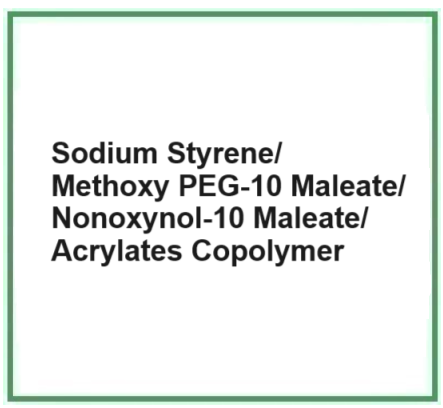Sodium Styrene/Methoxy PEG-10 Maleate/Nonoxynol-10 Maleate/Acrylates Copolymer is a chemical compound, the sodium salt of a polymer of styrene, methoxy PEG-10 maleate, nonoxynol-10 maleate and a monomer consisting of acrylic acid, methacrylic acid or one of their simple esters.
Sodium Styrene/Methoxy PEG-10 Maleate/Nonoxynol-10 Maleate/Acrylates Copolymer is a complex synthetic copolymer primarily used as a film-forming, stabilizing, and thickening agent in cosmetic formulations. Its unique combination of monomers, including styrene, maleate, and acrylates, makes it particularly useful in makeup, skincare, and haircare products, where it provides light, flexible hold and enhances the stability and texture of formulations.
Chemical Composition and Structure
This copolymer is composed of several monomers:
- Styrene: Provides film-forming properties, helping to create a thin, durable layer on the skin or hair.
- Methoxy PEG-10 Maleate: A derivative of maleic acid, offering moisturizing and conditioning properties.
- Nonoxynol-10 Maleate: Acts as a surfactant and solubilizer, improving ingredient dispersion in the formulation.
- Acrylates: Polymers known for their ability to provide flexibility and strength, contributing to the elasticity of the film formed by the copolymer.
The copolymer's structure allows it to create a continuous, flexible film on the surface of the skin or hair, enhancing product durability and providing a light, non-sticky feel.
The name describes the structure of the molecule:
- Sodium Styrene indicates the presence of styrene, an organic compound, in its sodium salt form. Styrene is often used in the production of polymers and plastics.
- Methoxy PEG-10 Maleate indicates the presence of a PEG (polyethylene glycol) derivative modified with a methoxy group and maleate. PEG is known for its solubilizing properties and texture enhancement.
- Nonoxynol-10 Maleate is another PEG derivative, modified with nonoxynol (a type of ethoxylate) and maleate.
- Acrylates Copolymer refers to a copolymer formed from acrylic monomers. Acrylates copolymers are used for their film-forming and stabilizing properties in cosmetic formulations.
Description of Raw Materials and Their Functions
Styrene. An aromatic monomer used as the main component in the copolymer. It provides the basic structure and contributes to the physical properties of the copolymer.
Methoxy PEG-10 Maleate and Nonoxynol-10 Maleate. Surfactants used to modify the solubility and surface properties of the copolymer.
Acrylates. Monomers that provide flexibility and adhesion to the copolymer. They contribute to the formation of a stable polymer network.
Sodium. Used to neutralize some components of the copolymer, improving water solubility and stability of the final product.
Industrial Chemical Synthesis of the Copolymer
- Preparation. The synthesis begins with mixing the ingredients: styrene, methoxy PEG-10 maleate, nonoxynol-10 maleate, and acrylates.
- Polymerization. These monomers are polymerized together, often in the presence of a catalyst, to form the copolymer.
- Neutralization. During or after polymerization, the copolymer is neutralized with sodium to improve its solubility and physical properties.
- Reaction Control. The reaction is monitored to ensure that the polymerization occurs correctly and that the copolymer has the desired properties.
- Purification. After polymerization, the copolymer is purified to remove impurities and by-products.
- Quality Control and Packaging. The sodium styrene/methoxy PEG-10 maleate/nonoxynol-10 maleate/acrylates copolymer undergoes quality checks and is then packaged for use in cosmetic and personal care products, where it utilizes its properties as a film-forming and stabilizing agent.
Form and Color
Typically appears as a viscous liquid, clear or slightly opaque.

What it is used for and where
Sodium Styrene/Methoxy PEG-10 Maleate/Nonoxynol-10 Maleate/Acrylates Copolymer is used in products like hair gels, lotions, and creams for its ability to form films, improve texture, and stabilize emulsions.
Cosmetics
Opacifying agent. This additive is inserted into formulations that may be translucent or transparent to make them opaque and less permeable to light.
Since the PEG (Polyethylene glycol) family is very numerous and can be found in cosmetic, industrial, pharmaceutical, medical and other products, we need to make an introductory statement on the subject, which is rather complex from a safety point of view because these products not only come into contact with the skin, but, as in the case of medical products, are ingested.
PEGs (polyethylene glycol) polymerise condensed ethylene oxide and water and are referred to as polyethylene glycols, but are actually complex chemical components, polymers bonded together. For example, plastic is polyethylene and has a hard consistency, while polyethylene combined with glycol forms a liquid. PEGylation is produced not only as etherification, but also as transesterification, which is the transformation of an alcohol by an ester.
The number appearing after the abbreviation PEG represents the molecular weight and the higher this number is, the less it penetrates the skin.
Safety. The term 'eth' refers to the ethoxylation reaction with ethylene oxide after which residues of ethylene oxide and 1,4-dioxane, chemical compounds considered carcinogenic, may remain. The degree of safety therefore depends on the degree of purity of the compound obtained. At present, no manufacturer is known to provide this information on the label.
![]() Sodium Styrene/Methoxy PEG-10 Maleate/Nonoxynol-10 Maleate/Acrylates Copolymer
Sodium Styrene/Methoxy PEG-10 Maleate/Nonoxynol-10 Maleate/Acrylates Copolymer 


